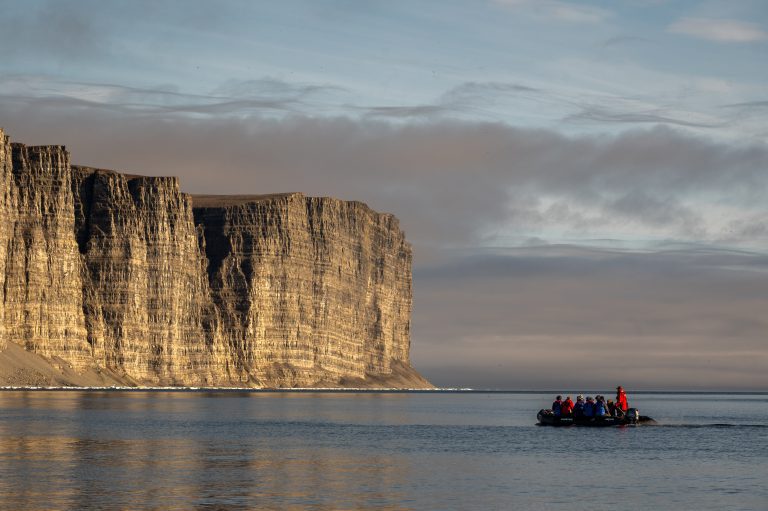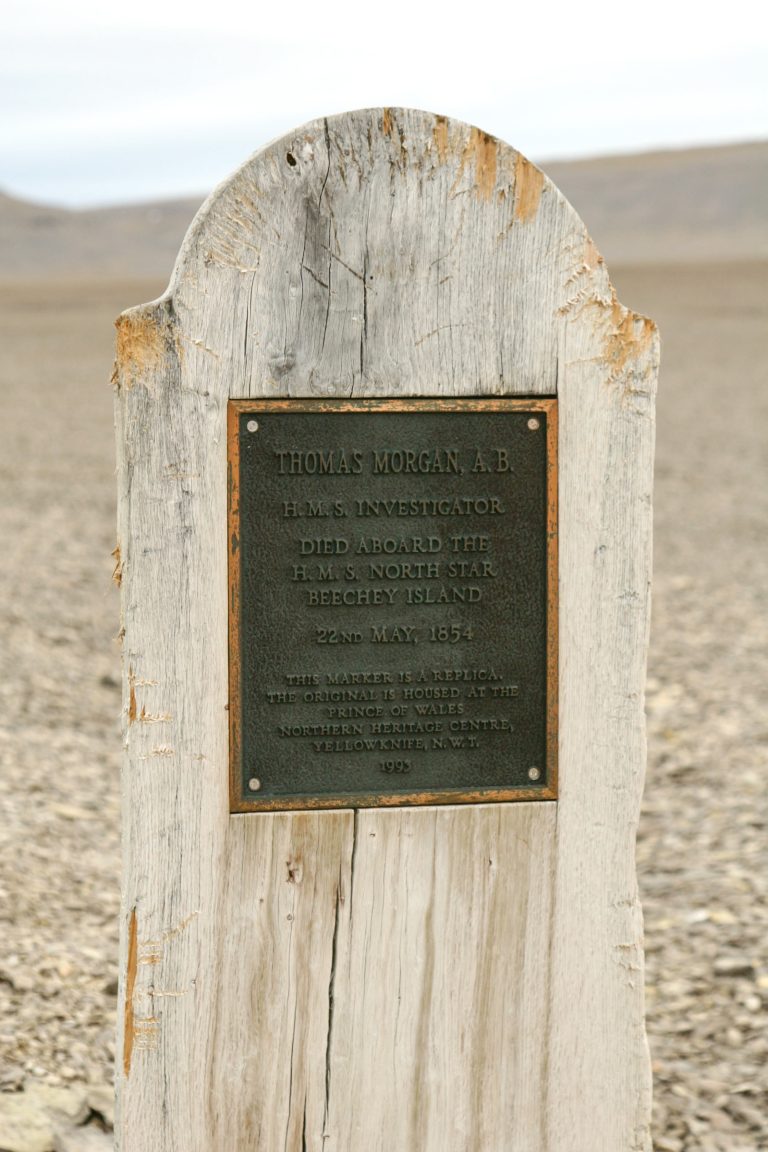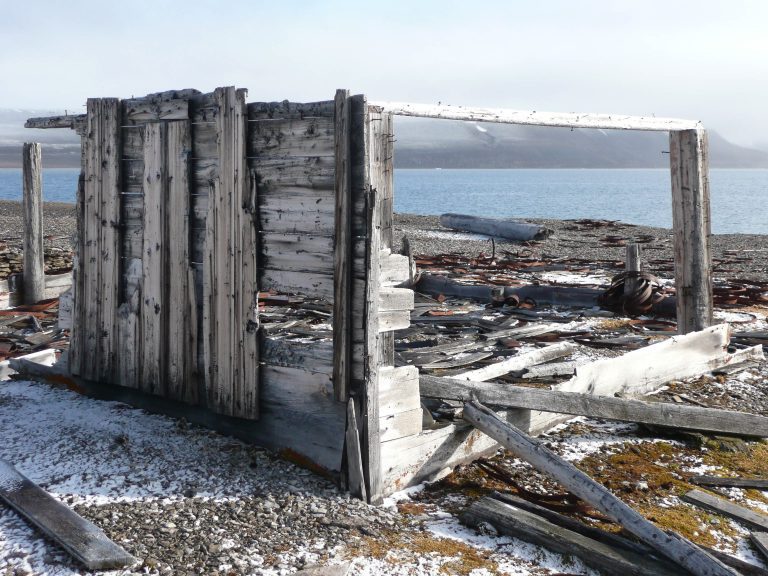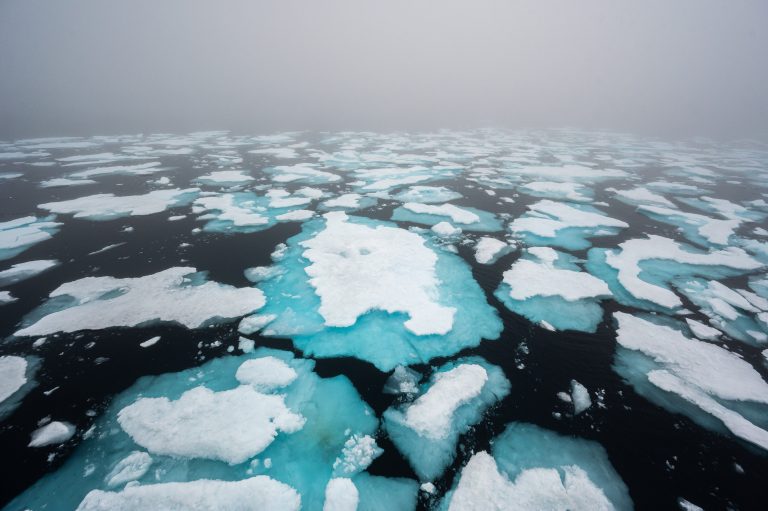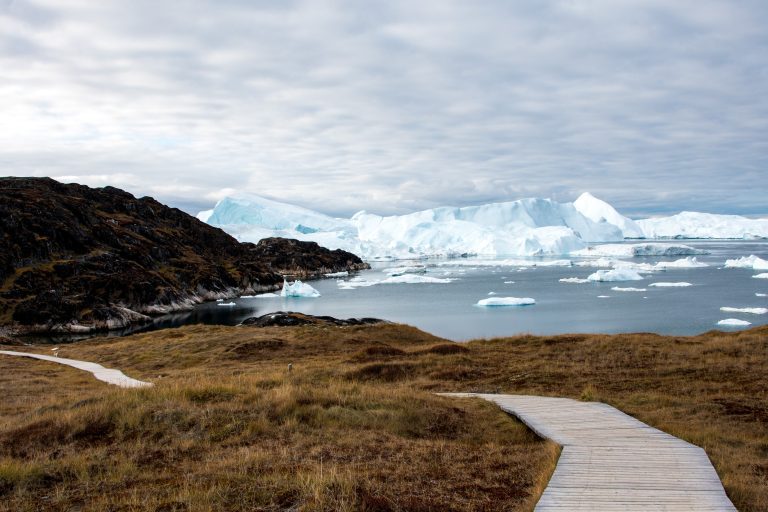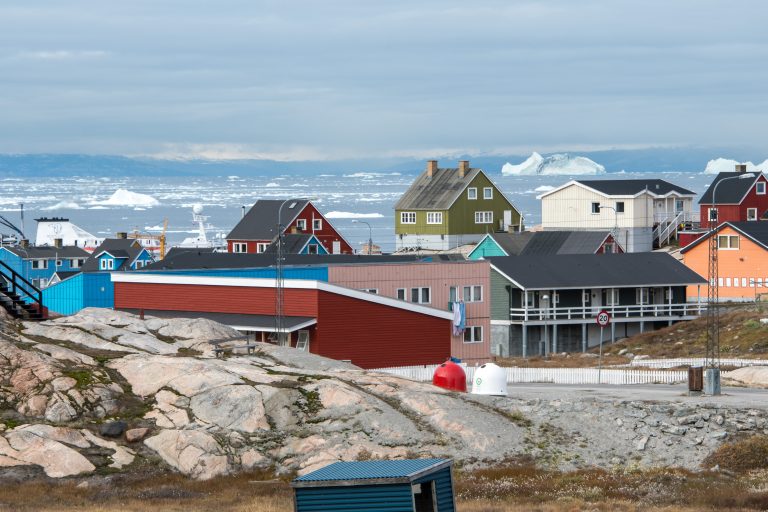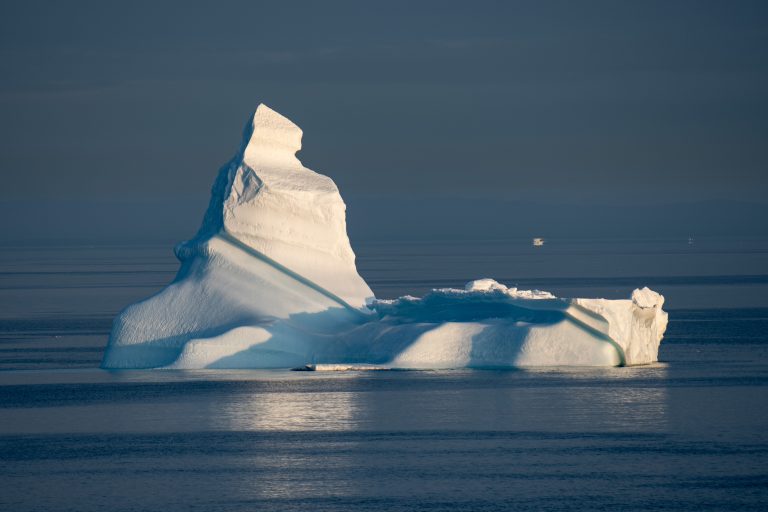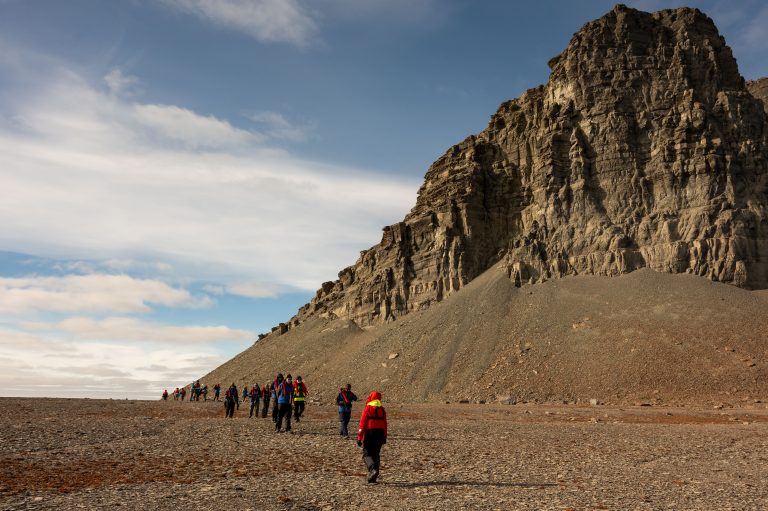
Traversing the Northwest Passage - 29 Days
Onboard Greg Mortimer – 130 passengers
On this epic voyage inspired by Roald Amundsen’s historic expedition, we attempt to sail the full length of the Northwest Passage, carving our way west from Greenland through the labyrinthine maze of waterways that hug the fabled islands of Arctic Canada until we reach the Beaufort Sea. Building on our classic Northwest Passage voyage, we visit historical sites explored by heroic explorers, meet the local Inuit that call this region home, marvel at striking landscapes and search for enigmatic wildlife found in this unique corner of the world. Pack ice may halt our voyage through the passage, so brace yourself for a genuine expedition where adventure awaits at every turn.
Voyage Highlights:
- The sheer thrill and adventure of attempting a full transit of the Northwest Passage from West Greenland to Nome
- Be greeted by the warm hospitality of the local Inuit, whose deep connection to the land is evident in their culture, traditions and lifestyle
- Watch for iconic arctic wildlife, including musk oxen, polar bears, seals and perhaps narwhal
- Adventure awaits on a genuine expedition where nature determines where you go and what you see
- In Ilulissat, hike to the UNESCO World Heritage-listed Icefjord and stand in awe of its immensity
- Discover Disko Island’s breathtaking icebergs and stunning geological wonders
Tour Dates
-
Aug 20 - Sep 17, 2026 (29 days)
Itinerary
Day 1: Arrive in Toronto
Having made your way to Toronto Airport, check-in at our group hotel located near the airport for an overnight stay. Accommodation: Westin Toronto Airport Hotel (or similar)
Day 2: Charter flight to Nuuk, Greenland & Embarkation
After breakfast at the hotel, board our charter flight to Nuuk, Greenland, where our vessel the Greg Mortimer awaits. After boarding, there is time to settle into your cabin before our important safety briefings. This evening, meet your expedition team and crew at the Captain’s Welcome Drinks.
Day 3: Sisimiut
Greenland’s second largest town, Sisimiut is located approximately 54 kilometres (33.5 miles) north of the Arctic Circle, meaning that during summer, you can experience the midnight sun here. The town is famous for the old blue church with the gate made of whale bone. In the cosy museum next door to the church, you will find an excellent reconstruction of an Inuit turf house as well as exhibits of local history and early life in Greenland. Sisimiut offers hiking trails with various degrees of difficulty. The easier trails take you through the town itself, its outskirts and into the mountains, where you will find spectacular vantage points.
Approximately 4,500 years ago, the Saqqaq culture arrived from Canada and settled in the area. They lived here for approximately 2,000 years, after which they mysteriously disappeared from the area. The Dorset culture arrived around 500 CE and stayed until the 1200s until they were replaced by the Thule culture, and today, most of the population of Sisimiut are descendants of the Thule culture.
Day 4: Illulissat
In the afternoon we arrive in Ilulissat. Known as the ‘birthplace of icebergs’, this region produces some of the most dazzling icebergs found anywhere in the Arctic. Hike past the husky sledge dogs to the UNESCO World Heritage-listed Icefjord and stand in awe at its immensity. Sermeq Kujalleq, also known as Jakobshavn Glacier, is the most productive glacier – not only in Greenland but the entire Northern Hemisphere. It produces 20 million tonnes of ice each day, all floating into the Ilulissat Icefjord and Disko Bay.
Days 5-7: Northwest Greenland expedition cruising
Explore the northern stretches of West Greenland, home to traditional settlements and enormous icebergs that Greenland is famous for. Possibilities include Zodiac cruises, hikes and a visit to one of the small communities that are dotted along the coast. Kayakers can enjoy paddling among the icebergs and keeping watch for whales that frequent the area.
Day 8: At sea, enter Canada
Our team of experts entertain us with informative talks about wildlife, geology and epic tales of early explorers such as Franklin and Amundsen.
Day 9: Pond Inlet (Mittimatalik), Nunavut, Canada
After clearance into Canada, we hope to visit Pond Inlet (Mittimatalik), a captivating Inuit community nestled on the northern tip of Baffin Island. Surrounded by towering ice-capped mountains, vast glaciers, and pristine fjords, this remote outpost offers an unparalleled wilderness experience. As you step ashore, you’ll be greeted by the warm hospitality of the local Inuit, whose deep connection to the land is evident in their culture and lifestyle. Immerse yourself in their traditions through engaging cultural encounters and gain insights into their unique perspective on life in the Arctic.
Days 10-12: Devon Island, Lancaster Sound
At a latitude of almost 75° degrees north, we are now truly in the High Arctic. Here, nutrient-rich waters support an abundance of wildlife, giving the area the moniker ‘wildlife superhighway’ of the Arctic. Devon Island (Tallurutit) is the largest uninhabited island on Earth and features stunning geology, with flat-topped mountains and glacial valleys giving Devon Island its unique character. We hope to visit Dundas Harbour to enjoy offers walks on undulating tundra, and perhaps some birdwatching. A dilapidated Royal Canadian Mounted Police outpost and remnants of a Hudson’s Bay Company trading post can be found here. In the bay, walruses are often present. Other possible places that we might visit include Croker Bay and Maxwell Bay.
At the western end of Devon Island lies Beechey Island (Iluvilik), where we plan to land. Named after Frederick William Beechey, the island is a designated Canadian National Historic Site. During the Franklin expedition of 1845–46, Franklin attempted to sail through the Northwest Passage with HMS Erebus and HMS Terror, with perilous results – three of his men are buried here. Roald Amundsen landed at Beechey Island in 1903, during the first successful voyage by ship to fully transit the Northwest Passage from the Atlantic Ocean to the Pacific Ocean.
Just a short distance away, Radstock Bay offers a captivating contrast to the open sea. Here, we’ll disembark via Zodiac onto a beach strewn with remnants of the past. Explore the ruins of a Thule village nestled beneath the imposing Caswell Tower, where well preserved stone dwellings coexist with artifacts from later explorers. Witness the stark beauty of this remote bay, characterised by its dramatic cliffs, gravelly beaches, and the scattered remains of whale skeletons that have shaped the landscape and the lives of those who called it home.
Days 13–17: Expedition cruising
In genuine expeditionary style, our itinerary for the following days is heavily dependent on weather conditions and unpredictable sea ice. The following places are some that we hope to visit.
Prince Leopold Island (Appait)
On the southern side of Lancaster Sound from Beechey Island lie the towering bird cliffs of Prince Leopold Island (Appait), a historic site where in 1848, English explorer James Clark Ross overwintered during the search for the missing Franklin expedition. Prince Leopold Island is the most important bird sanctuary in the Canadian Arctic, with approximately 500,000 birds nesting here in summer. Ringed seals are often spotted on the sea ice around the island and polar bears often lurk nearby.
Port Leopold
Port Leopold, a barren, windswept bay on the northeastern corner of Somerset Island (Inuktitut Kuuganajuk), is steeped in history. Here, the crews of HMS Enterprise and Investigator were forced to endure a harsh winter while searching for the lost Franklin expedition. Their presence is indelibly marked on a rock engraved with “1849” and the ships’ initials. The desolate landscape is punctuated by a lone Hudson Bay Company hut, a failed trading post from the 1920s. Hikers will have the opportunity to explore the coastline, discovering the historic Hudson Bay Company house and intriguing Inuit archaeological sites. Be amazed by the otherworldly formations shaped by the region’s freezing and thawing cycles, which our expedition team will detail during recap. Nearby, a cairn marks the spot where Ross’s rescue expedition left vital supplies.
Hazard Inlet (Qariaraajuk)
We hope to visit an Inuit site inhabited by bowhead whale hunters during the 15th and 16th centuries. The remains of over 100 bowheads are scattered across the village and beach, a testament to the community’s reliance on this marine giant. Excavations have uncovered around 20 sod houses, though evidence suggests there may have been as many as 40. The cliff face behind the site holds community burial grounds, while caches, kayak, and umiak stands line the shore. This remarkable site offers a poignant glimpse into the lives of these Inuit families, who worked cooperatively to hunt bowhead whales for sustenance and building materials. It’s an extraordinary privilege to experience this piece of history firsthand.
Point Zenith
Point Zenith, a rocky promontory jutting into the ocean, offers breathtaking panoramic views. As you step ashore, you’ll feel a profound sense of isolation and wonder. This is a place where time seems to stand still, and the only sounds are the wind and the crunch beneath your boots.
King William Island (Qikiqtaq)
Remains attributed to the Franklin expedition have been found at 35 different locations on King William Island (Qikiqtaq) and on nearby Adelaide Peninsula. South of Cape Felix, in Victoria Strait, we hope to Zodiac close to where the wrecks of HMS Erebus and HMS Terror were eventually found in 2014 and 2016, respectively.
Cambridge Bay (Iqaluktuuttiaq)
The administrative and transportation hub of the region, Cambridge Bay (Iqaluktuuttiaq) is the largest stop for passenger and research vessels traversing the Northwest Passage and unofficially marks the midpoint for voyages of the Northwest Passage. Zodiac ashore for an exploration of this Inuit settlement located in the high arctic. Enjoy a walk through the village, where you can visit the local church, visitor centre and support the local community by purchasing some locally made handicrafts.
Day 18-22: Coronation and Amundsen Gulfs
Your experienced expedition team will create your day-by-day itineraries based on sea ice and weather conditions. Apart from Franklin, other heroic explorers including Amundsen explored this territory, and we may visit the same places as early explorers. We hope to meet the resilient locals who make the extreme far north their home.
Below are some of the places in the area that we may visit:
Johansen Bay, Edinburgh Island (Egloovikan)
We hope to enjoy a Zodiac excursion within an estuary of at the northeast end of Johansen Bay and up the river towards the lake. Wildlife including caribous, reindeer, arctic foxes, hares and peregrine falcons frequent the area.
Nearby, Edinburgh Island (Egloovikan) is a small and uninhabited island in Canada’s Nunavut region. The scenery consists of colourful flowering shrubs, beaches tinged in stunning ochres, while the surrounding cliffs shaded in rich, deep tones. A possible walk to a lookout overlooking the lake offers spectacular views over lakes, sea and mountains.
Port Epworth (Kugluktoalok)
The Tree River area on the mainland — also known a Port Epworth — provides a spectacular backdrop our possible exploration, with its river and shallow lakes, striking sedimentary rock outcrops, and bright autumnal colours of tundra. This area is also known for its stromatolites – the petrified remains of ancient mounds of algae, formed some two billion years ago by the same microorganisms responsible for producing the oxygen we breathe today.
Smoking Hills (Ingniryuat), Franklin Bay
The Smoking Hills (Ingniryuat) in Canada’s Northwest Territories have been smouldering, sending plumes of gas across the landscape, for centuries. Technically sea cliffs, you would be forgiven for thinking that the multicoloured fiery natural phenomenon is the set to an apocalyptic movie depicting the end of the world. The smoke is caused by layers of combustible, sulphur-rich lignite (brown coal) that ignites and emit sulphurous gas into the air, when exposed to erosion and landslides, which also creates a dazzling colouration of the rocks.
Days 23-25: Beaufort Sea
Excitement builds as we sail the Beaufort Sea. Whether you are out on deck or in the comfort of one of the observation lounges, watch as the captain navigates our state-of-the-art vessel through these waterways, which are frozen for most of the year. Keep a close watch for wildlife including Beluga whales and polar bears that are often seen here.
Cruising further west, we hope to Zodiac cruise (subject to permitting) to Herschel Island. This historic island, inhabited by the Thule people for over a millennium, was first charted by Sir John Franklin in 1825. It later transformed into a bustling whaling station during the late 19th century, supporting a winter community of hundreds and a fleet of ships. However, the industry’s decline in the early 20th century led to the island’s gradual abandonment. Today, protected as a territorial park, Herschel Island offers a unique glimpse into the region’s rich history and stunning Arctic wilderness.
At Prudhoe Bay, we farewell Canada and enter the United States.
Days 26-27: Chukchi Sea and Bering Strait
As we sail westwards to Nome, along the northern coast of Alaska to where the U.S and Russia are only 100 km (60 miles) apart, separated by the Bering Sea, there is ample time to reflect on our adventures while scanning the water for marine life. Share, edit and submit pictures in our photo competition and attend final lectures from our team of onboard experts. We hope to get permission to ship cruise close by Point Hope, Little Diomede and King islands in Alaska.
Day 28: Disembark in Nome & Fly to Anchorage
In Nome, farewell your expedition team and crew after sharing a once-in-a-lifetime voyage together. After disembarking, we transfer to the airport for your charter flight to Anchorage for an overnight stay. Accommodation: Captain Cook Hotel Anchorage (or similar)
Day 29: Depart Anchorage
After breakfast, check-out your hotel and transfer to the airport for your onward journey.
In true expedition style we encourage exploration and adventure, offering flexibility in challenging environments in a way that puts you among the action to see and do as much as possible. This itinerary is only a guide and subject to change due to ice and weather conditions.
Route Map

Trips and Rates
Please note, rates are Per Person in USD
Single Travelers:
- If willing to share a cabin, we can match you with another passenger of the same gender to avoid a single supplement.
- Single occupancy price for a double/twin cabin is 1.5x the per person share price
- Starting the Arctic 2026 season there will be 6 dedicated Solo Balcony Stateroom A cabins, 2 Solo Balcony Stateroom B and 2 Solo Balcony Stateroom C cabins available with no single supplements. Pricing based on full brochure fare. See pricing grid for details.
Adventure Options:
- Kayaking Program – requires previous kayaking experience and an intermediate paddling level:
- $690/person on Spitsbergen: Realm of the Ice Bear (8 days)
- $830/person on Wild Landscapes of West Greenland
- $870/person on Jewels of the Arctic (12 day trips)
- $980/person on Svalbard Odyssey, Jewels of the Arctic (15 Days), Greenland Odyssey, Southern Greenland
- $1,190/person on Svalbard in Depth, Northwest Passage (16-17 day trips) & Northern Lights Explorer
- $1,660/person on Arctic Complete
Single Travelers:
- If willing to share a cabin, we can match you with another passenger of the same gender to avoid a single supplement.
- Single occupancy price is 1.5x the per person share price
Adventure Options:
- Kayaking Program: $1,330/person on 12-15 day Antarctica voyages, $1,745/person on 20+ day Antarctica & South Georgia voyages and $1,030/person on 9 day Express trip. Requires previous kayaking experience and an intermediate paddling level.
- Paddling: $640/person
- Camping: $165/person
- Snorkeling: $675/person on 12-14 day Antarctica voyages, $835/person on 20+ day Antarctica & South Georgia voyages and $515/person on 9 day Express trip.
- Alpine Trekking: $1260/person
- Snowshoeing: $370/person on 12-15 day Antarctica voyages and $440/person on 20+ day Antarctica & South Georgia voyages
- Ski/Snowboard Touring: $1395/person – experience required
- Shackleton Crossing on Skis: $2,220/person – experience required
Availability & prices are subject to change at anytime. Please contact us for the real time availability & prices.
Cabin Descriptions

Captain's Suite
The largest of all the cabins, the Greg Mortimer’s singular Captain’s Suite will take you to the polar regions in ultimate style and comfort. Complete with large lounge area, balcony, walk-in wardrobe and en-suite, you’ll need to book early to secure this suite. The Captain’s Suite features additional amenities including 1 free pair of binoculars per suite, free stocked mini bar (replenished as needed) and 1 free bottle of champagne.
Cabin & balcony combined size: 479 sq. ft. (44.5m2 )
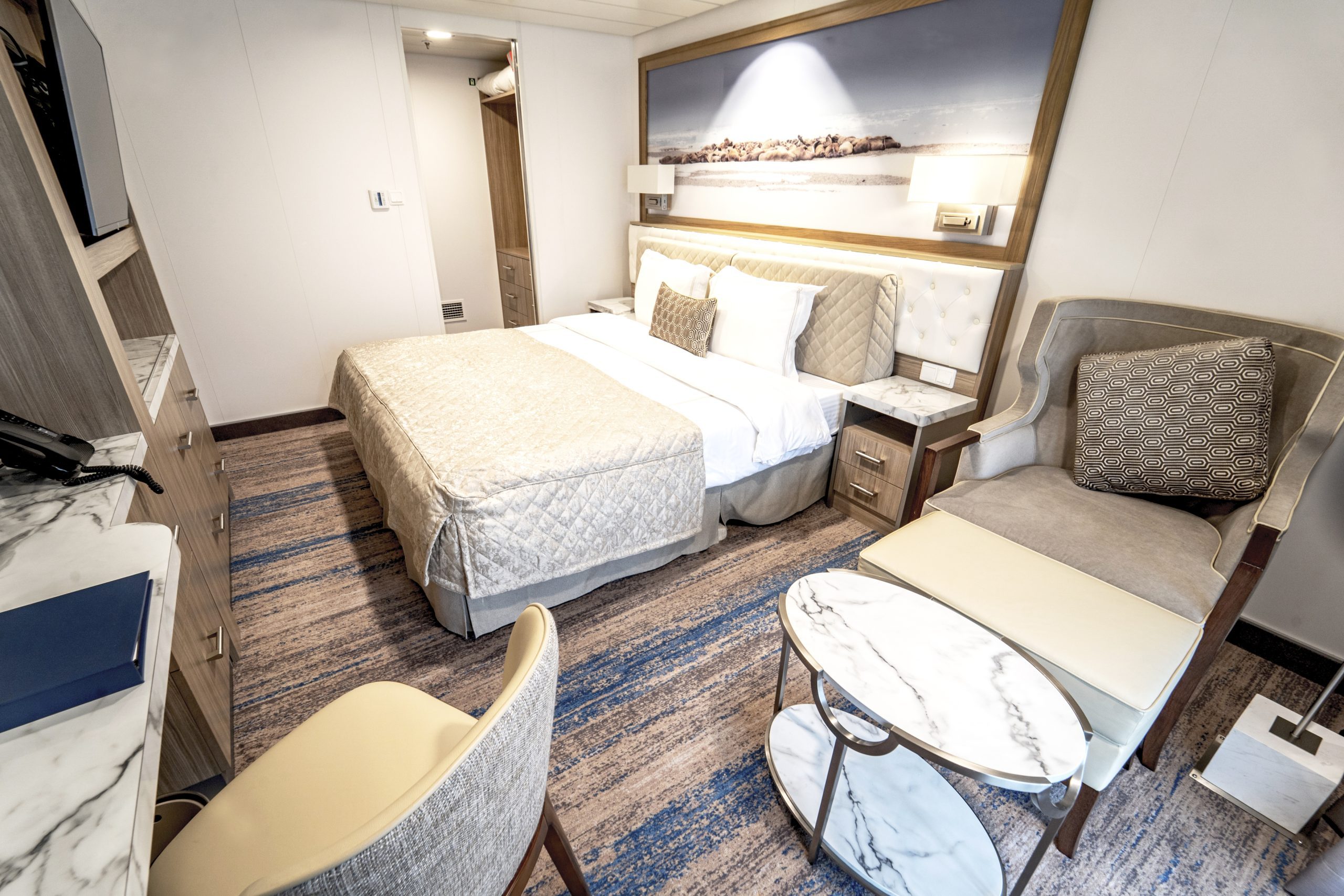
Junior Suite
The Greg Mortimer’s four Junior Suites take in some impressive scenery from their vantage points on Deck 7. When you aren’t enjoying a landing, you can relax in the suites’ separate lounge area, or just watch the world float by from the private balcony. The Junior Suite features additional amenities including 1 free pair of binoculars per suite, free stocked mini bar (stocked once only) and 1 free bottle of champagne.
Cabin & balcony combined size: 419 sq. ft. (39m2)
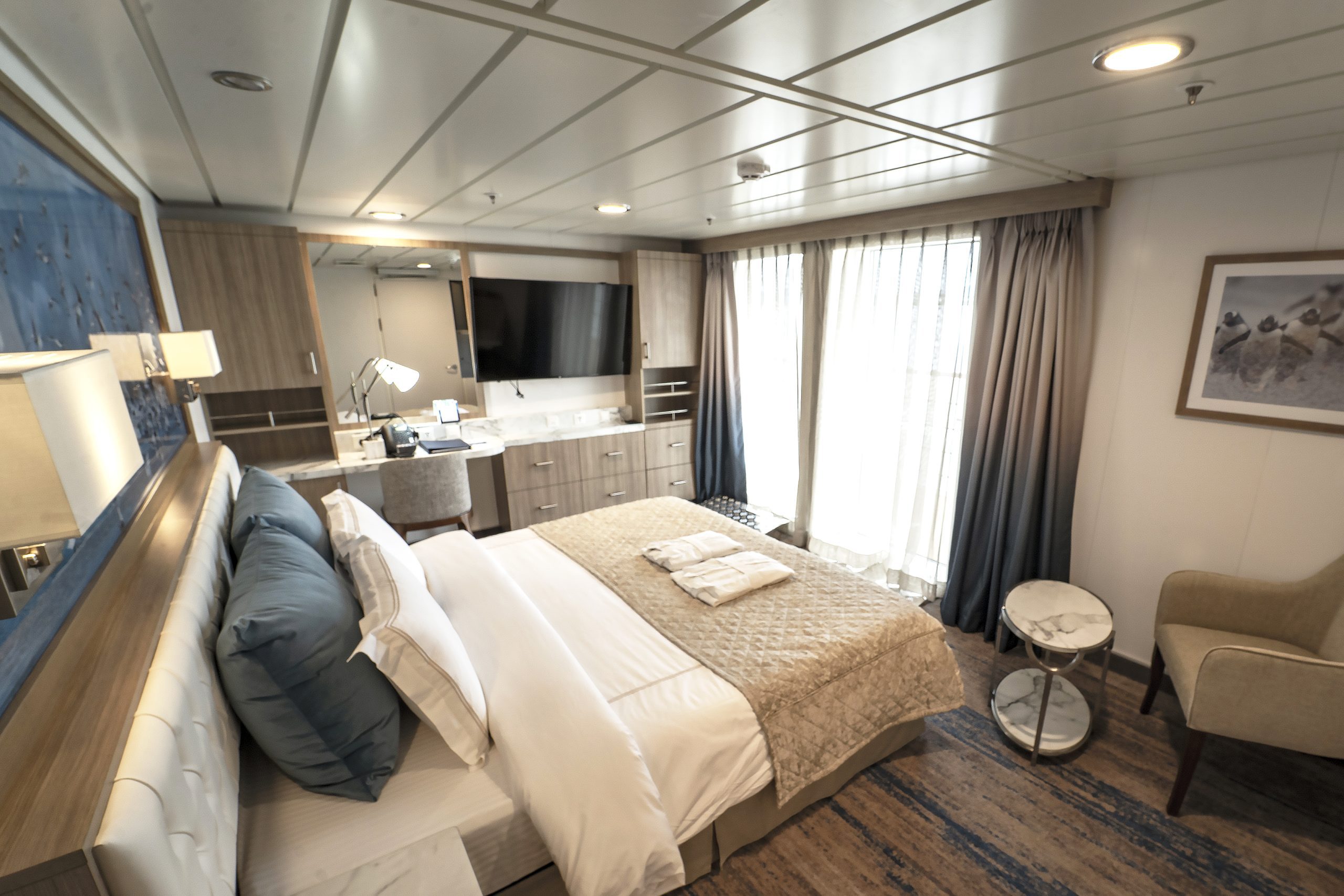
Balcony Stateroom Superior
With a bit more room to stretch the legs, the Balcony Stateroom Superior cabins are perfect for polar adventurers who travel with plenty of gear. Located on Deck 4 & 6, the Staterooms feature floor to ceiling windows, en-suite bathrooms and a comfortable desk area. Some of these rooms are equipped with wheelchair accessible bathrooms.
Cabin & balcony combined size: 303 – 432 sq. ft. (28.2 – 40.2m2 )
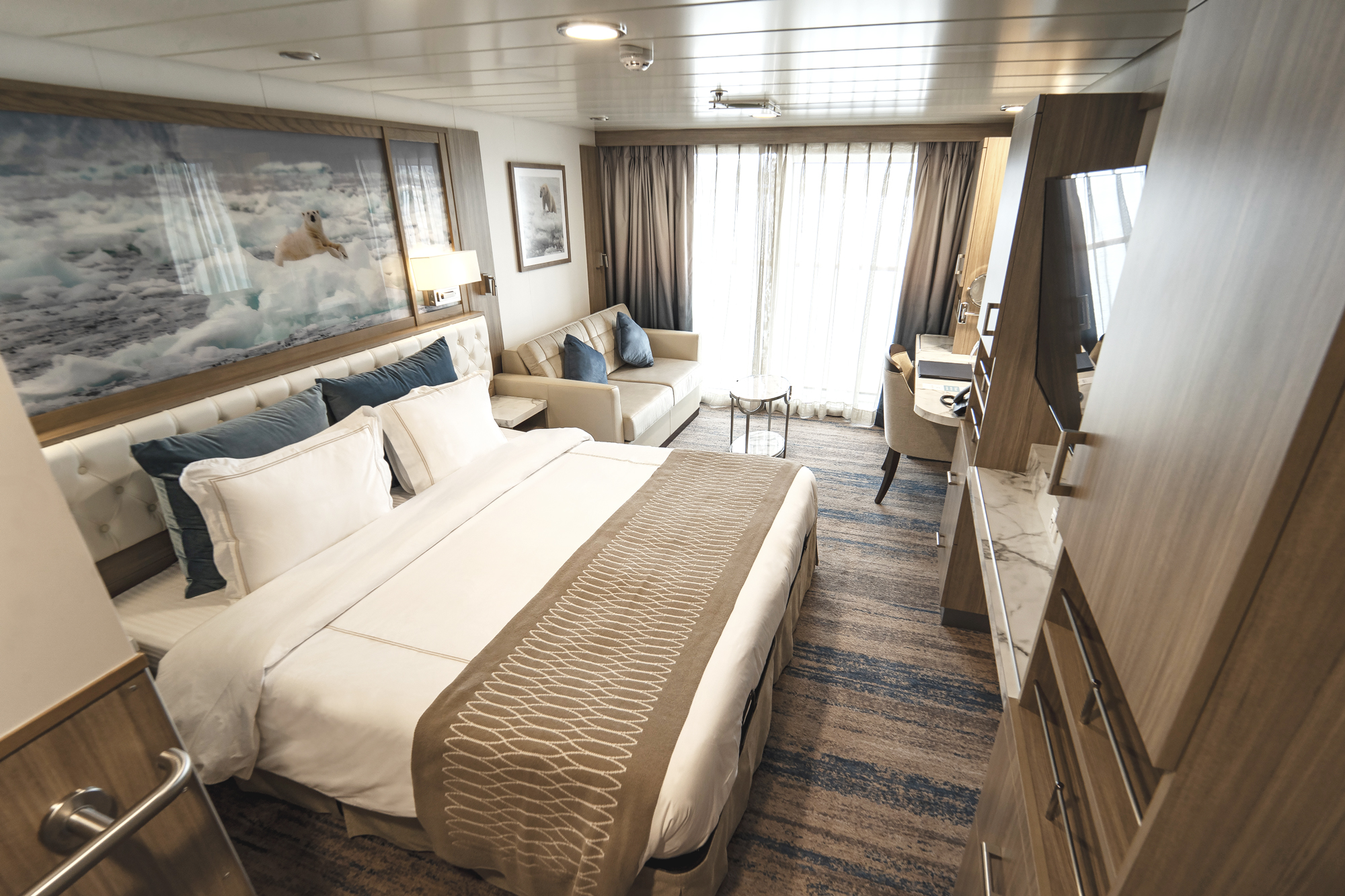
Balcony Stateroom A
The 23 Balcony Stateroom A cabins are a premium cabin and the most abundant on board. These cabins are located in preferred positions on Deck 4 and 6 which provides easy access between Decks via the internal stairs or elevator.
Cabin & balcony combined size: 259 – 301 sq. ft. (24 – 28m2)
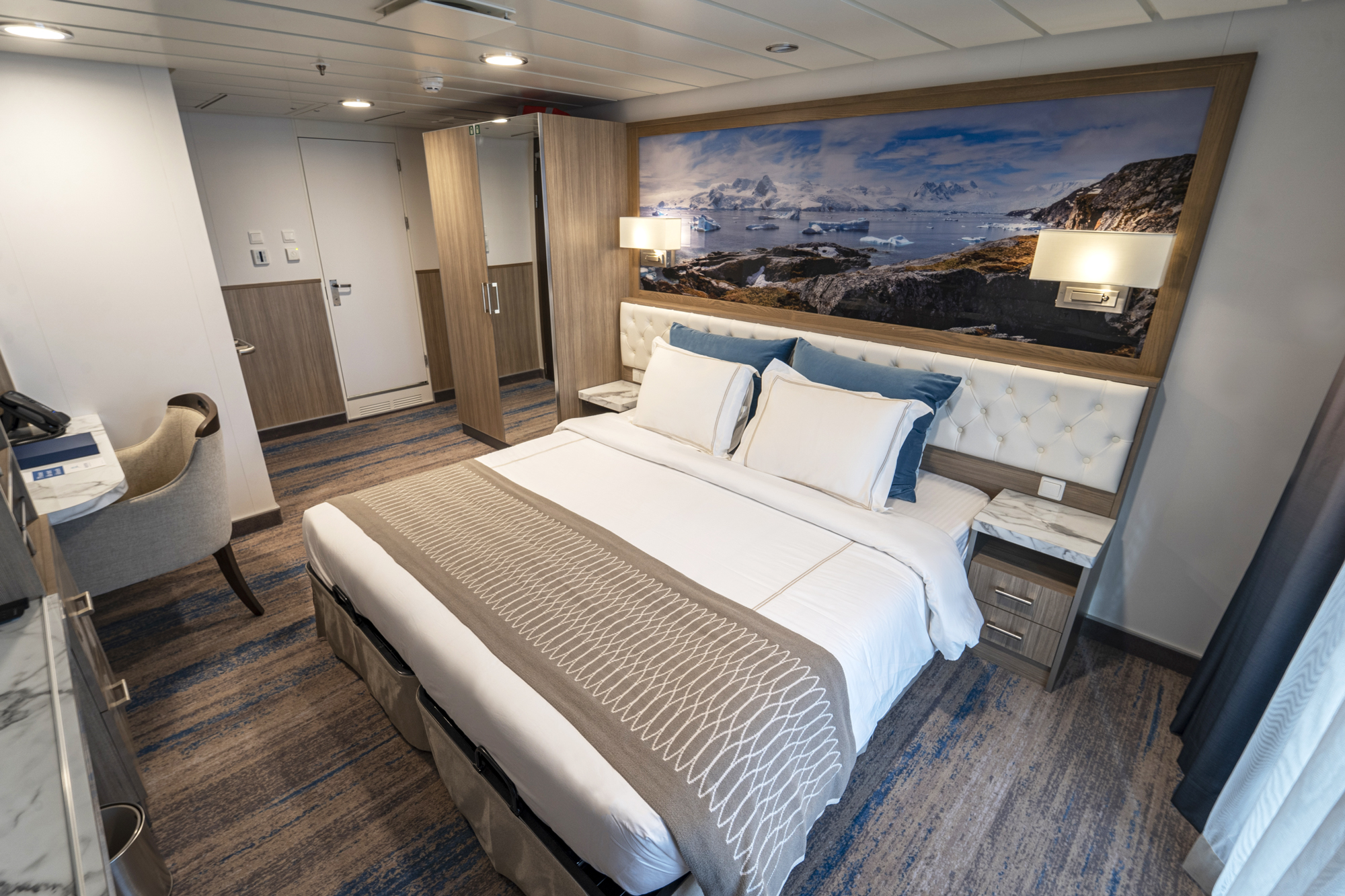
Balcony Stateroom B
The 21 Balcony Stateroom B Cabins are located at the fore and aft of Deck 4 & 6. Many are fitted with interconnecting features making them great for families or groups.
Cabin & balcony combined size: 254 – 267 sq. ft. (23.6 – 24.8 m2 )
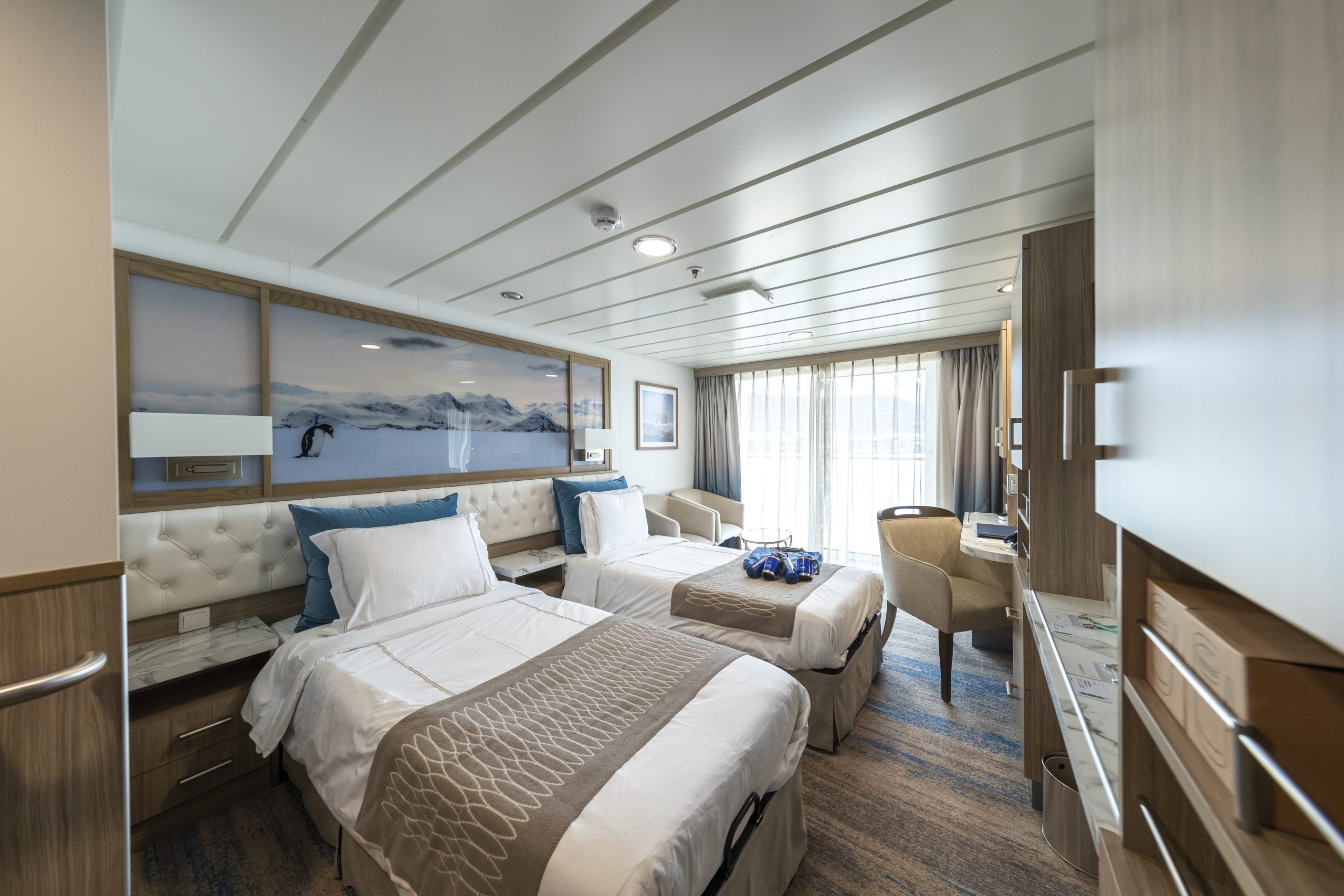
Balcony Stateroom C
The 14 Balcony Stateroom C’s are the most economical balcony cabins fitted with all the necessities and comfortable for up to 2 people. These cabins are on Deck 4 & 6, either in the most forward or aft location or in a mid-ship location with a smaller cabin size.
Cabin & balcony combined size: 225 – 267 sq. ft. (21-24.8 m²)
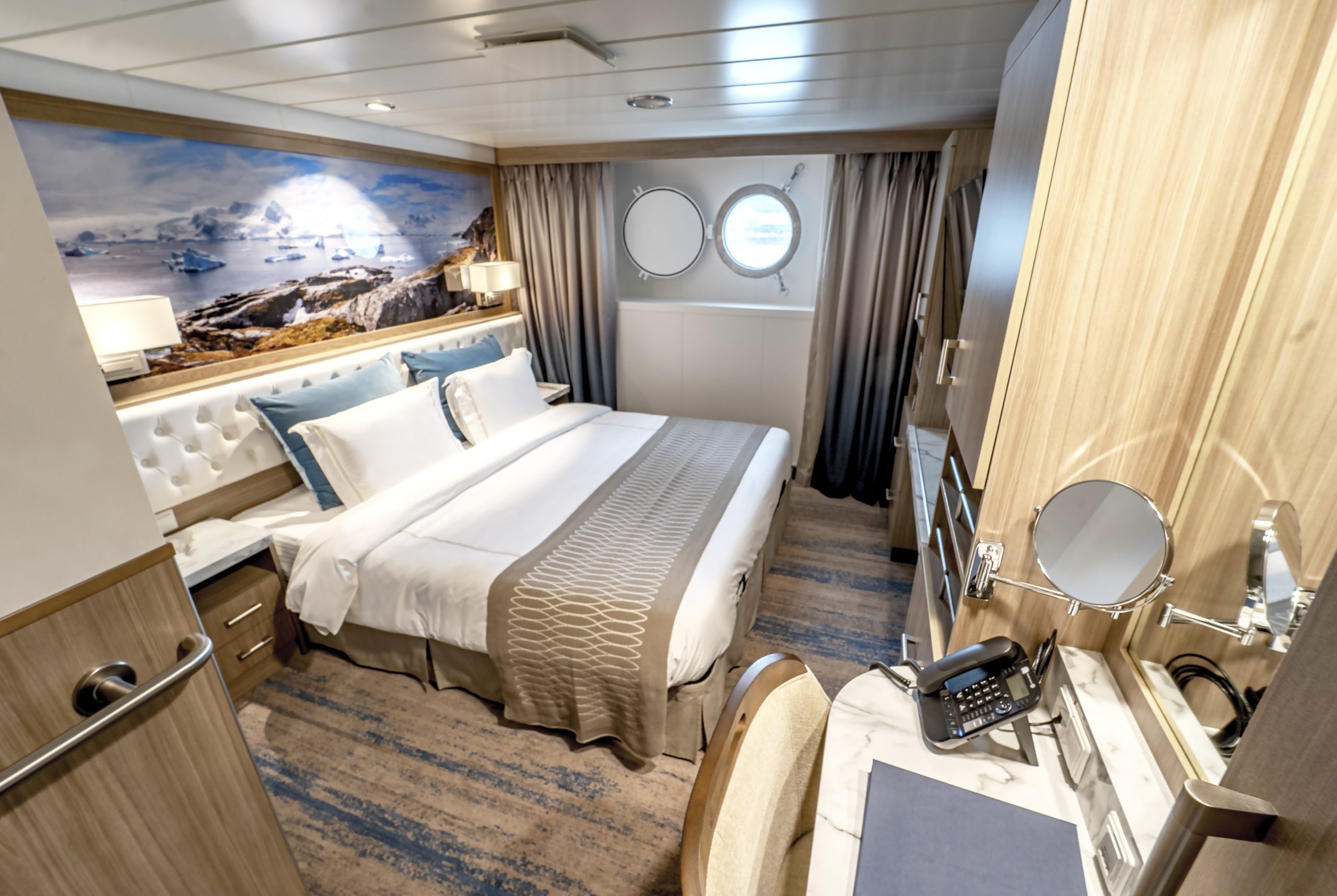
Aurora Stateroom Twin
The Greg Mortimer features eight Aurora Stateroom Twin cabins featuring portholes, all with private en-suites. Located on Deck 3, they’re close to the mudroom and loading platforms, perfect for adventurers who are looking for a comfortable base that’s close to the action.
Cabin size: 170 – 245 sq. ft. (15.8 – 22.8 m²)
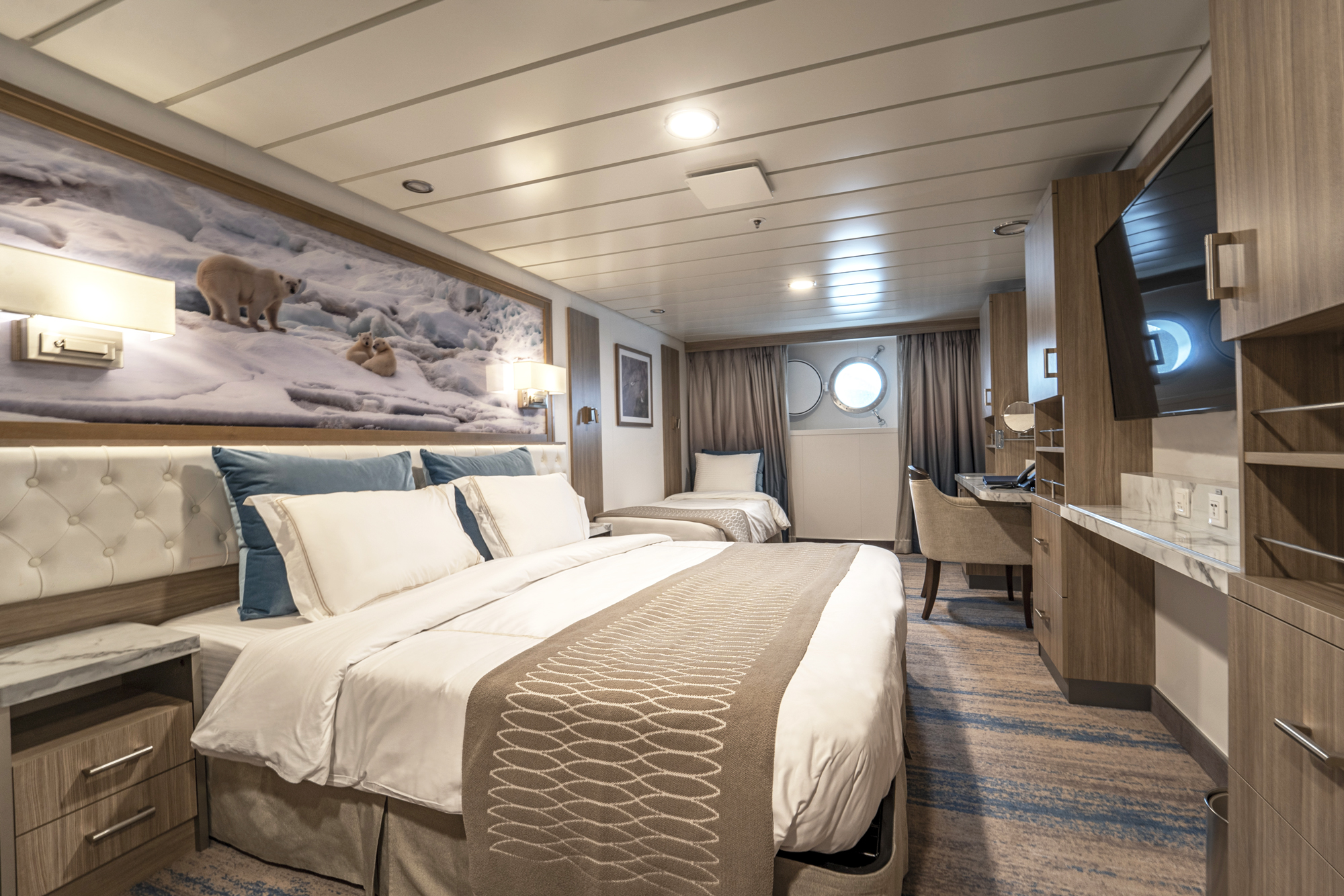
Aurora Stateroom Triple
There are six Aurora Stateroom Triple cabins featuring portholes, all with private en-suites. Located on Deck 3, they’re close to the mudroom and loading platforms. *Please note the Aurora Stateroom Triple cabins are only available on certain departures.
Cabin size: 230 – 245 sq. ft. (21 – 23 m²)
Deck Plan
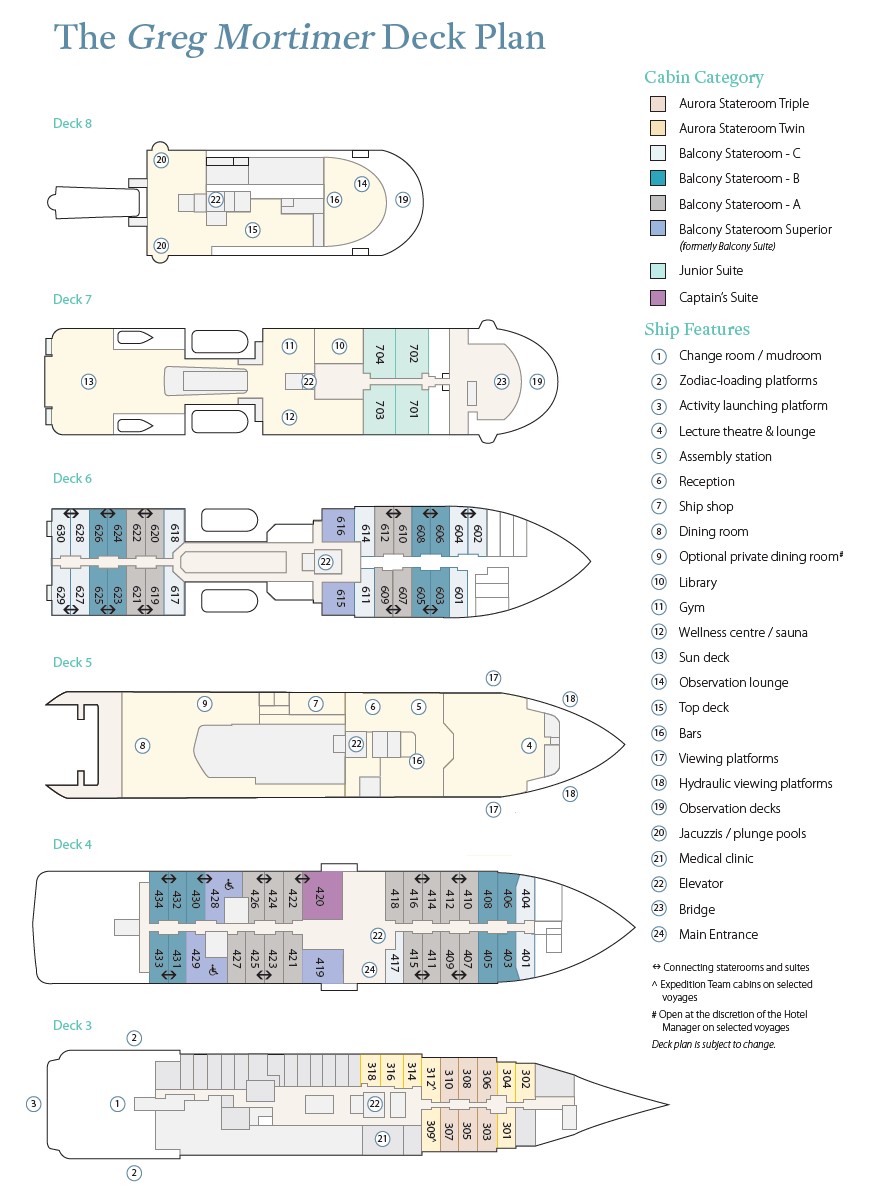
Inclusions & Exclusions
Inclusions:
- All airport transfers mentioned in the itinerary.
- One night’s hotel accommodation including breakfast, in Toronto on Day 1.
- Charter flight from Toronto to Nuuk on Day 2.
- Charter flight from Nome to Anchorage on Day 28.
- One night’s hotel accommodation including breakfast, in Anchorage on Day 28.
- On-board accommodation during voyage including daily cabin service.
- All meals, snacks, tea and coffee during voyage.
- Beer, house wine and soft drinks with dinner.
- Captain’s Farewell reception including four-course dinner, house cocktails, house beer and wine, non-alcoholic beverages.
- All shore excursions and Zodiac cruises.
- Educational lectures and guiding services provided by Expedition Team.
- Complimentary access to onboard expedition doctor and medical clinic (initial consultation).
- One 3-in-1 waterproof polar expedition jacket.
- Complimentary use of Muck Boots during the voyage.
- Comprehensive pre-departure information.
- Port surcharges, permits and landing fees.
- Wi-Fi. Please note we travel to remote regions and therefore the connection can be unreliable.
Exclusions:
- International or domestic flights not mentioned in the itinerary, unless specified in the itinerary.
- Transfers – unless specified in the itinerary.
- Airport arrival or departure taxes.
- Passport, visa, reciprocity and vaccination fees and charges.
- Travel insurance or emergency evacuation charges.
- Hotel accommodation and meals unless specified in the itinerary.
- Optional excursions and optional activity surcharges.
- All items of a personal nature including but not limited to alcoholic beverages and soft drinks (outside of dinner service), gratuities, laundry services, personal clothing, medical expenses, or phone charges.
Note: A $15 USD per person per day gratuity for the crew is automatically added to your onboard account. It is at your discretion if you would like to remove the tip (or adjust the amount) when you settle your bill. It is not necessary to tip the expedition team members. This gratuity amount is included for suites as part of their ‘Suite Benefits’
